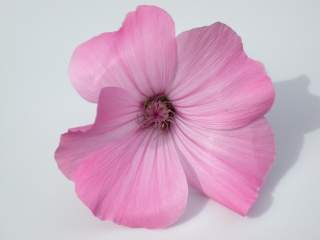 Lavatera
trimestris L.,
Lavatera
trimestris L.,back to Annual Mallows
back to Digital Herbarium
more images
 Lavatera
trimestris L.,
Lavatera
trimestris L.,
![]() Rose
Mallow, Royal Mallow, Regal Mallow, Annual Mallow
Rose
Mallow, Royal Mallow, Regal Mallow, Annual Mallow ![]() Bechermalve,
Garten-Strauchpappel, Trichtermalve,
Bechermalve,
Garten-Strauchpappel, Trichtermalve,
![]() Bekermalva,
Grootbloemige Lavatera, Kaasjeskruid,
Bekermalva,
Grootbloemige Lavatera, Kaasjeskruid,
![]() sommarmalva,
poppelros,
sommarmalva,
poppelros,
![]() mamelukærme,
mamelukærme,
![]() Sommerstokkrose,
Hagepoppelrose
Sommerstokkrose,
Hagepoppelrose
![]() Aftanroðablóm,
Aftanroðablóm,
![]() Malva
basta
Malva
basta ![]() Kesämalvikki,
Kesämalvikki,
![]() aed-rõngaslill,
aed-rõngaslill,
![]() Vrtni
grmièasti oslez,
Vrtni
grmièasti oslez,
![]() Slazówka
trójdzielna,
Slazówka
trójdzielna,
![]() slézovec
tøímìsíèní
slézovec
tøímìsíèní
![]() flor
de bispo
flor
de bispo
Distribution: Lavatera trimestris is found in the Mediterranean region, from Morocco, Portugal, Spain and Southern France to Turkey and the Levant, including the Balearic Islands, Corsica, Sardinia, Sicily, Malta and Greece. It is naturalised in other some other locations in Europe (e.g. Baden-Würtemmburg) and on other continents, including in the states of North Carolina, California, Texas, Missouri, Vermont and Connecticut, and more generally in the mid-west and south-east of the USA, where it is often sold as an element in wildflower meadow seed mixes. In the British Isles it occurs as a casual in southern England.
Habitat:
Identification: L. trimestris is readily distinguished from any other cultivated mallow.
Malope trifida is also an annual with large trumpet shaped flowers. It is not particularly similar to L. trimestris, but if a single trait is desired for the separation of these two species, the bases of the petals of Malope trifida don't overlap, and hence the green calyx can be seen through the gaps between the petals.
L. trimestris can be distinguished from the other European annual Lavateras (L. p. punctata and L. p. maroccana) by the expansion of the central axis of the fruit above the mericarps in L. trimestris. L. punctata also has a purplish cast to the stems, and is more finely hairy.
Description (based on cultivar 'Loveliness')
|
This is a tall upright annual (to 4 ft in the wild, but cultivated strains are often shorter) herb with bristly stems. The stems are green, developing an indistinct reddish tint with age, and are sparsely covered with hairs. |
||
|
The showy bright pink (or white) trumpet shaped flowers are from 1-2½ in across, borne singly within the leaf axils, from mid-summer to late autumn. The flower consists of an epicalyx of 3 segments, a calyx of 5 sepals, a corolla of 5 petals, an androecium and a gynoecium of 12 or more styles. The base of the androecium forms a tube surrounding the styles. |
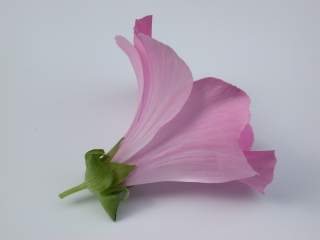
|
|
|
The petals are up to 1-2½ in long, overlapping for most of their length. They are obovate (with bluntly rounded ends) and cuneate. They are variously white, rose or pink in colour, with a satiny sheen. In cultivar 'Loveliness' they are rose-pink. |
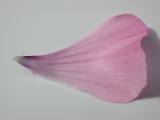 |
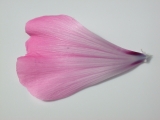 |
|
The sepals are about 15mm long. They are narrowly ovate, acutely terminated, and connate for about a third of their length, with a sparse covering of short hairs. |
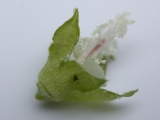 |
|
|
The epicalyx segments are 3-lobed, acute, and connate for about half their length, with a sparse covering of short hairs. They are symmetrically disposed. They are about 1cm long and about the same in width, in flower. The pedicel is about 2cm long, green, and covered in fine hairs. |
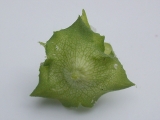 |
|
|
The leaves are borne alternately (one per node), subtended by two upright stipules. The lower leaves are 1-2 inches across, cordate, orbicular, and slightly broader than long; the upper leaves develop 3-7 shallow lobes. |
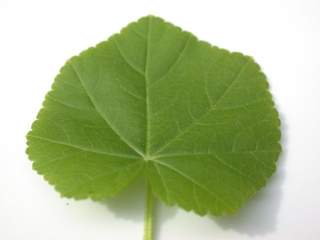 |
|
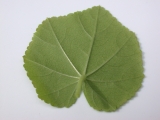 |
||
|
The stipules are impersistent, narrowly triangular to diamond shaped, and from 2-5mm in length. |
||
|
The fruit is a schizocarp divided into around 12 ridged, seed-bearing, mericarps, covered by a disc-like expansion of the central axis. |
||
 |
||
Variation: Both white and pink flowered plants occur in the wild. The former have been known as L.trimestris var alba, but f. alba would seem a more appropriate usage. Cultivated plants have larger flowers, and have been referred to as var grandiflora. They also show a wider range in flower colour. Many cultivated seed strains are smaller in height that the wild form.
Cultivated strains include 'Deep Pink', 'Loveliness' (3-4 ft, deep rose-pink), 'Mont Blanc' (21 in, white), 'Mont Rose' (21 in, pink), 'Pastel' (mixed colours), 'Pink Beauty' (24 in, pale pink), 'Pink Regis' (presumable a paler pink version of 'Ruby Regis'), 'Rose Beauty' (24-30 in, pink), 'Ruby Regis' (24 in, cerise-pink), 'Salmon Beauty' (24-30 in, salmon pink?), 'Silver Cup' (24 in, pink), 'Splendens Alba', 'Splendens Sunset', 'Tanagra' (deep rose-pink), 'White Beauty' (24-30 in, white), 'White Cherub' (syn 'Dwarf White Cherub') (12-15 in, white), and 'White Regis' (presumably a white version of 'Ruby Regis').
'Parade' is a mixture of 'Mont Blanc', 'Pink Beauty', 'Ruby Regis' and 'Silver Cup'. 'Beauty Mix' is presumably a mixture of the various 'Beauty' strains. 'Dutch Beauty', 'Easter Parade' and 'Pastel Mixed' are similar mixtures. 'Dutch Beauty' was bred for the cut flower trade.
A reference to a cultivar 'Silver Chalice' has been encountered. This may be the same as 'Silver Cup'.
 |
 |
 |
 |
 |
 |
 |
 |
| Loveliness | Mont Blanc | Pink Beauty | Rose Beauty | Ruby Regis | Silver Cup | White Beauty | White Cherub |
Var malvæformis Ball, from Rereya in Morocco, has smaller pale purple flowers. Another varietal form is var. brachypoda Perez Lara.
Cultivation: L. trimestris is cultivated as an annual. Seed is sown indoors in early spring, or outdoors in late spring. The plant is reasonably tolerant of soil and aspect, but does best in a sunny location, and prefers well-drained, not over-fertile, soil. L. trimestris produces good seed in temperate climates, and sometimes self-sows.
L. trimestris is intolerant of transplantation, and is best sown in situ, or in modules.
Pest and Diseases: L. trimestris is a food plant for the Mallow Skipper (Carcharodus alceae and Carcharodus tripolina: Hesperidae) and the Mallow Moth (Larentia clavaria: Geometridae). The former is absent in the British Isles, where the latter feeds primarily on the common wild mallow Malva sylvestris.
L. trimestris is susceptible to cherry leaf roll nepovirus, Elm mottle ilarvirus, malva vein clearing potyvirus, okra mosaic tymovirus, poplar mosaic carlavirus, strawberry latent ringspot (?) nepovirus, tomato bushy stunt tombusvirus and watermelon mosaic 2 potyvirus.
Cytology: L. trimestris is a diploid with 14 chomosomes. It is one of only two diploids within Malva and Lavatera, the other being L. phoenicea
Taxonomy:
Lavatera trimestris Linn., Sp. Pl. 692. (1753)
L. trimestris Linn. is the type species of the genus Lavatera, and hence will be classified in that genus as long as that genus is recognised.
L. trimestris is fairly isolated within Lavatera.
Synonyms:
References
Bibliography
Photographs
photograph at Landskrona
photograph of cultivar ('Beauty') at botany.com
photograph of cultivar ('Deep Pink') at Perennial Pleasures Nursery
photograph of cultivar ('Mont Blanc') at Cerny Seeds
photograph of cultivar ('Pink Beauty') at Perennial Pleasures Nursery
photograph of cultivar ('Pink Beauty') at Hortiplex
photograph of cultivar ('Salmon Beauty') at Hortiplex
photograph of cultivar ('Silver Cup'?) at Ed Hume Seeds
photograph of cultivar ('Silver Cup') at Cerny Seeds
photograph of cultivar ('Tanagra') at eseeds.com
photographs of cultivars at Henriette's Herbal Homepage
photographs of cultivars at Camera Arborea
photograph of naturalised plant in North Carolina
back to Annual Mallows
more images
Acknowledgements and Copyright
text, photographs and HTML © 2002 Stewart Robert Hinsley